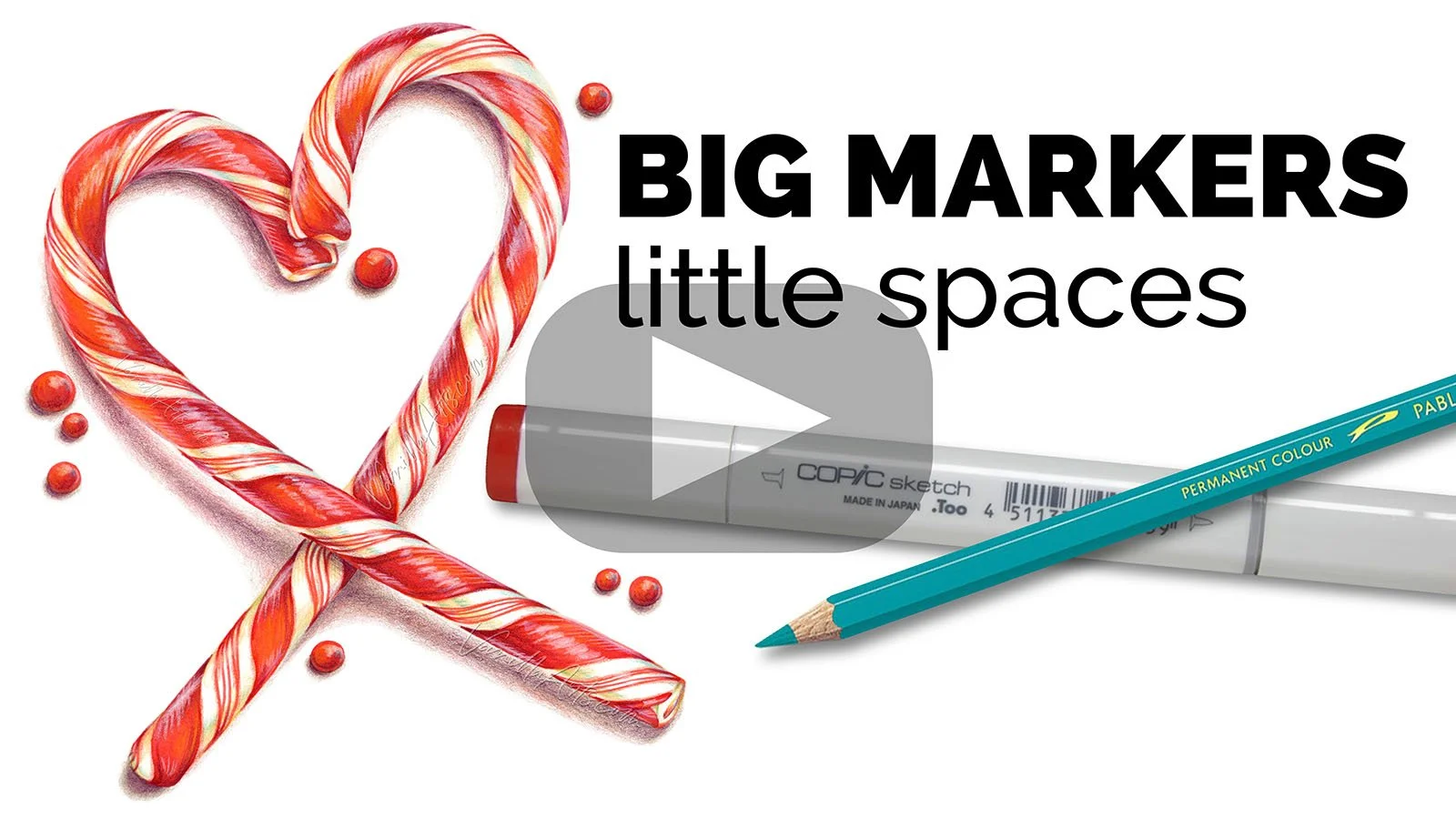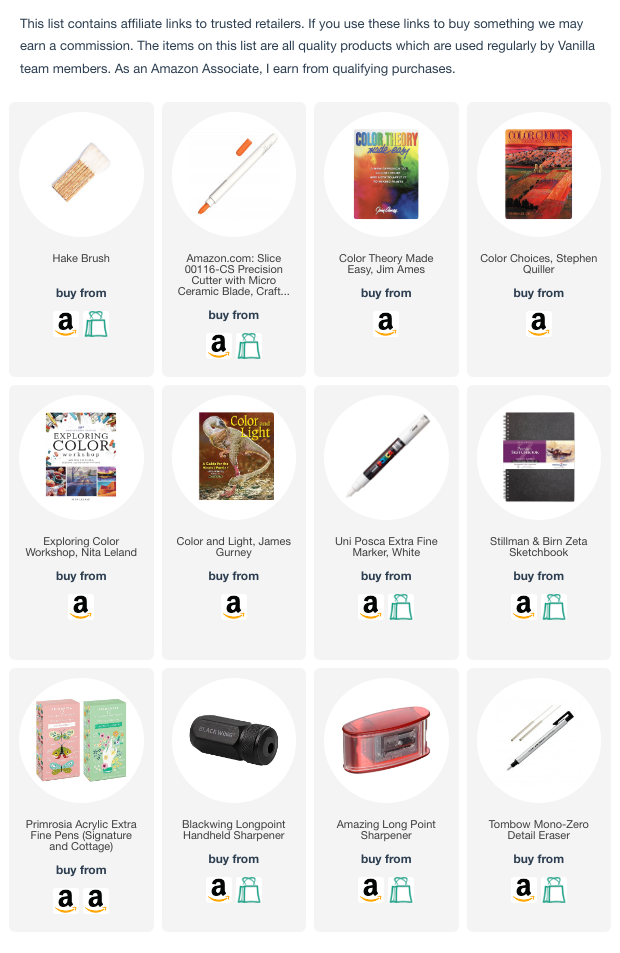Vanilla Beans: Algorithm Crumbs
Thanks for taking the jump to read today’s newsletter. If you landed on this page by accident, subscribe to the Vanilla Beans Newsletter here.
I looked at the calendar yesterday and screamed.
Where did autumn go?
It’s snowing outside as I type this.
Again, where did autumn go?
If you see my missing season, please pop it into an envelope and mail it back to me. I’m always losing stuff…
Algorithm Crumbs
I’m frequently asked if it’s possible to learn to draw, color, or paint from YouTube.
It’s an interesting question— but really, I secretly think they’re asking for permission to not-pay for coloring classes.
They want validation for making the choice to self-educate.
Either that or they’re waiting to pounce, “Noooooo, you’re wrong! My friend learned to color using nothing but free resources! Neener-neener ha ha!”
So folks are always a little surprised when they pop the YouTube question and I respond with:
“Sure. You can learn a lot by watching YouTube. Go for it!”
I’m not even being snarky.
I honestly, completely, and totally 100% believe that someone is out there somewhere, and that person learned to color using nothing but free tutorials, blogs, and YouTube videos.
They’re out there.
The thing is, they don’t color very well.
Or at least not as good as they could if they’d had a better teacher.
You ask on any coloring forum, “Can someone recommend a good Copic instructor?” and there’s always someone who says
“Bahhhhhhh, you don’t need to spend money; it’s all on YouTube for free!”
And I’ve had people tell me this, directly and confrontationally, as if they’re daring me to punch them for insulting my profession.
Whatever.
I’ve been through the fire. Your comment is barely a scratch.
Back when I first introduced my 12 week course, Marker Painting Foundations, it was wayyyyyyyy more expensive than any other marker class around.
(unless you divided it by 12— then it was cheaper than everything else but people don’t do math anymore…)
Anyway, I had angry strangers emailing me out of the blue to tell me what an awful person I am, charging gullible people for free information.
I once clicked on a discussion thread about Copic SP’s being discontinued only to find the conversation had been sidetracked by complaints about my prices and my big, fat head.
No problem, folks. Head to YouTube. The information is all there.
Now I’ve written before about the questionable tips and techniques from self-appointed marker masters.
YouTube is full of experts with ten minutes of experience and hours of advice.
But misinformation is not our topic for today. Instead, let’s talk about when good info goes bad.
___
Let’s call her “ColorMama”.
ColorMama popped up a few years ago in a Facebook group.
And whoa, she said all the right stuff!
She had a very attainable goal. She was spending money on excellent instructional books. She was watching all the right YouTube channels. Somehow she was assembling all the right information into what looked like college level instruction.
I was impressed. ColorMama might actually do it!
Of all the people I’ve ever seen online, this woman had an the best shot at self-education. Beyond all the resources, she was even following the perfect practice schedule. ColorMama was crankin’ out 2-3 drawings a week.
The odds were in her favor.
And yet…
Despite all the right stuff, she still draws and colors as bad today as she did on day one.
Zero growth.
In fact, I just looked her up. I think her stuff has gotten worse over time. She’s gone from primitive to kinda creepy.
Now before you snicker…
I’m not telling you about ColorMama to be mean.
There’s a good lesson to be had here— and it’s such a good lesson that we’re going to be talking about various aspects for the next several weeks.
Let’s begin the series here:
There are limits to self education.
And the first limit is you.
Good resources are completely useless if you can’t process them.
When we self-instruct, we’re all over the place.
Oh, here’s a great book, I’ll flip through that… No wait, here’s a good video, let’s watch it… Oh cool! Here’s an excellent blog, let’s read all the articles!
Everywhere. All the things.
When we self-instruct, there’s no order in our learning process.
And I’m saying “we” because I do this too.
It’s advanced techniques one minute and beginner stuff the next. We flit around gobbling up every crumb of information as we stumble across it.
No problem! I’ll remember it later.
No you won’t.
Have you ever watched an old cartoon and been shocked at the dirty jokes you missed as a kid?
You missed the double entendres because you weren’t ready to hear them.
There’s a weird thing our brain does— when someone says something outside your field of context, your brain skips right over it, almost as if you never heard or saw it.
Which is why you’ve watched every episode of Grey’s Anatomy but can’t intubate anyone.
So if I spend the next ten minutes describing the chroma differences between romantic chiaroscuro and classical blah blah blah blabbity blah.
You can’t process what you’re not ready to hear.
This is why teachers are important.
There’s a reason kindergarten story hour doesn’t include particle physics.
Teachers limit what they present.
Teachers give you only the information you’re capable of absorbing when you’re best able to use it.
YouTube is not a teacher.
There’s a bleep-ton of awesome information on YouTube.
But you’ll miss 92% because you’re not ready to understand it.
When you buy art classes, you’re not paying for the information.
The lessons we’re teaching? The same information is available in your public library, in every book store, in art magazines, and all over the internet. It’s all out there, every little bit of it.
There’s nothing new in art education and there hasn’t been for centuries. Digital artists use the same techniques Da Vinci used.
Every technique I teach is somewhere on YouTube.
But that’s okay. INSTRUCTION is different than INFORMATION.
In a class, you’re paying for someone to present information in the correct order to facilitate effective learning.
Let’s be clear: The YouTube algorithm doesn’t care about you.
When you search “how to color a realistic eye”, the algorithm will feed you everything that’s ever been uttered about the human eyeball.
What the algorithm will never do is say,
“Hey, you know that paper you’re using? Something’s not right, it’s making the markers look weird.”
The algorithm won’t notice that you’re holding a Copic marker wrong.
The algorithm can’t see that you can’t blend.
And the algorithm will never tell you:
“Hey, maybe before you read this advanced tutorial you should probably have some basic drawing skills because this process is way above your head and if you do this stuff now, you’ll pick up some really bad habits which you’ll NEVER overcome. So here are the 20 beginner tutorials which you’ve very clearly skipped!”
A good art instructor will.
Next week, we’ll talk about the artistic Achille’s Heel.
NEW VIDEO
Click to watch. If your device doesn’t like embeds, click here to watch at YouTube.
IF YOU LIKED TODAY’S ARTICLE & VIDEO, PLEASE SUPPORT FUTURE FREE LESSONS
NEW DIGI STAMP
Got a Christmas sweetheart?
PURCHASE INCLUDES FULL SUPPLY LIST FOR EACH ORNAMENT COLOR
THIS WEEK IN COLOR
CURRENT PASSWORD: RubberDuckie
UPCOMING EVENTS
click to view details
THANKSGIVING & CHRISTMAS COLORING
click for more info



























